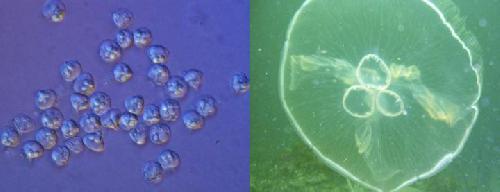Evolution had a few more drinks once again, according to a new paper in Proceedings of the National Academy of Sciences which wants to prompts a rethink of what it means to be an animal.
Jellyfish, those commonplace sea pests with stinging tentacles, have actually evolved over time into "really weird" microscopic organisms, made of only a few cells, that live inside other animals.
Genome sequencing confirms that myxozoans, a diverse group of microscopic parasites that infect invertebrate and vertebrate hosts, are actually are "highly reduced" cnidarians -- the phylum that includes jellyfish, corals and sea anemones.

"This is a remarkable case of extreme degeneration of an animal body plan," said Paulyn Cartwright, associate professor of ecology and evolutionary biology at KU and principal investigator on the research project. "First, we confirmed they're cnidarians. Now we need to investigate how they got to be that way."
Not only has the parasitic micro jellyfish evolved a stripped-down body plan of just a few cells, but via data generated at the KU Medical Center's Genome Sequencing Facility researchers also found the myxozoan genome was drastically simplified.
"These were 20 to 40 times smaller than average jellyfish genomes," Cartwright said. "It's one of the smallest animal genomes ever reported. It only has about 20 million base pairs, whereas the average Cnidarian has over 300 million. These are tiny little genomes by comparison."
Despite its radical phasedown of the modern jellyfish's body structure and genome over millions of years, Myxozoa has retained the essential characteristic of the jellyfish -- its stinger, or "nematocyst" -- along with the genes needed to make it.
"Because they're so weird, it's difficult to imagine they were jellyfish," she said. "They don't have a mouth or a gut. They have just a few cells. But then they have this complex structure that looks just like stinging cell of cnidarian. Jellyfish tentacles are loaded with them -- little firing weapons."
The findings are the stuff of scientific fascination but also could have a commercial effect. Myxozoa commonly plague commercial fish stock such as trout and salmon.
"They're a very diverse group of parasites, and some have been well-studied because they infect fish and can wreak havoc in aquaculture of economic importance," Cartwright said. "They cause whirling disease in salmon. The fish start swimming in circles -- it's a neurological problem caused by a myxozoan."
Cartwright said the confirmation that myxozoans are cnidarians would necessitate the re-classification of Myxozoa into the phylum Cnidaria. Moreover, these micro jellyfish could expand understanding of what makes up an animal.
"Their biology was well-known, but not their evolutionary origins," she said. "They're microscopic, only a few cells measuring 10 to 20 microns. Some people originally thought they were single-celled organisms. But when their DNA was sequenced, researchers started to surmise they were animals -- just really weird ones."
Indeed, Cartwright said traits scientists understood as vital for animal development are absent in Myxozoa.
"Hox genes are one example, which are important to development of all animals, and these lack them," she said. "But Myxozoa is definitely an animal because its evolutionary origin is shared with jellyfish, and we use species' ancestry to define them. But animals are usually defined as macroscopic multicellular organisms, and this is not that. Myxozoa absolutely redefines what we think of as animal."
While the dramatic changeover from macroscopic marine animal to microscopic parasite seems utterly unique, Cartwright thinks it might reveal a strategy in nature that could be more widespread than previously known.
"If it can happen once in evolution, it certainly can happen again," she said.




Comments